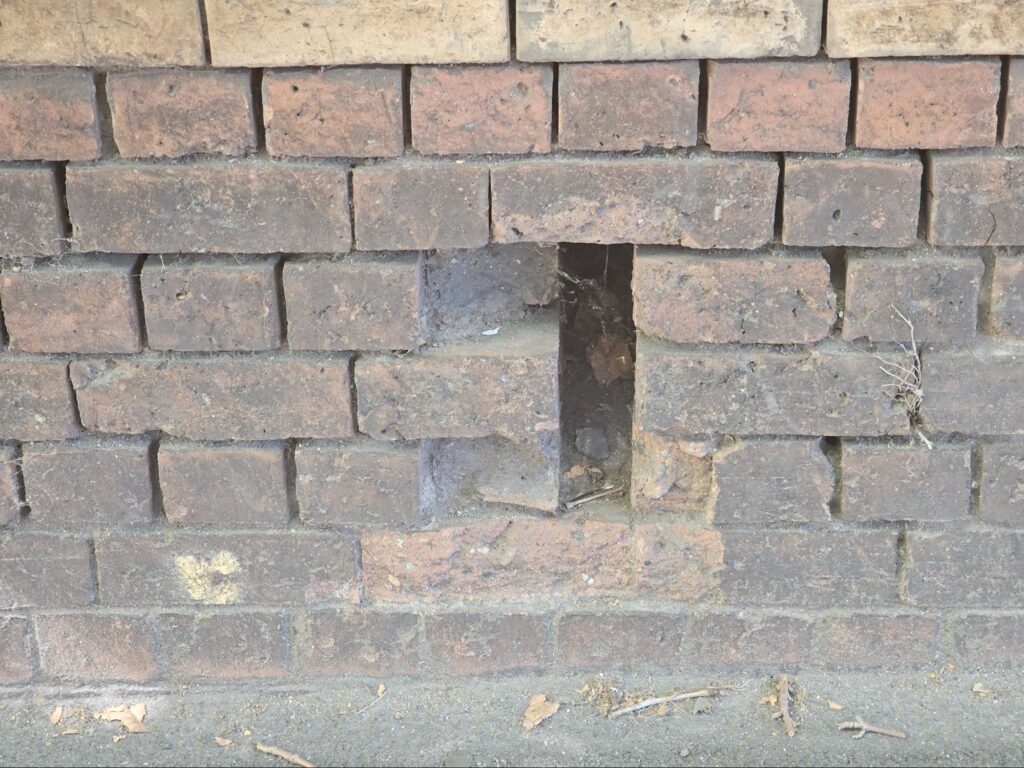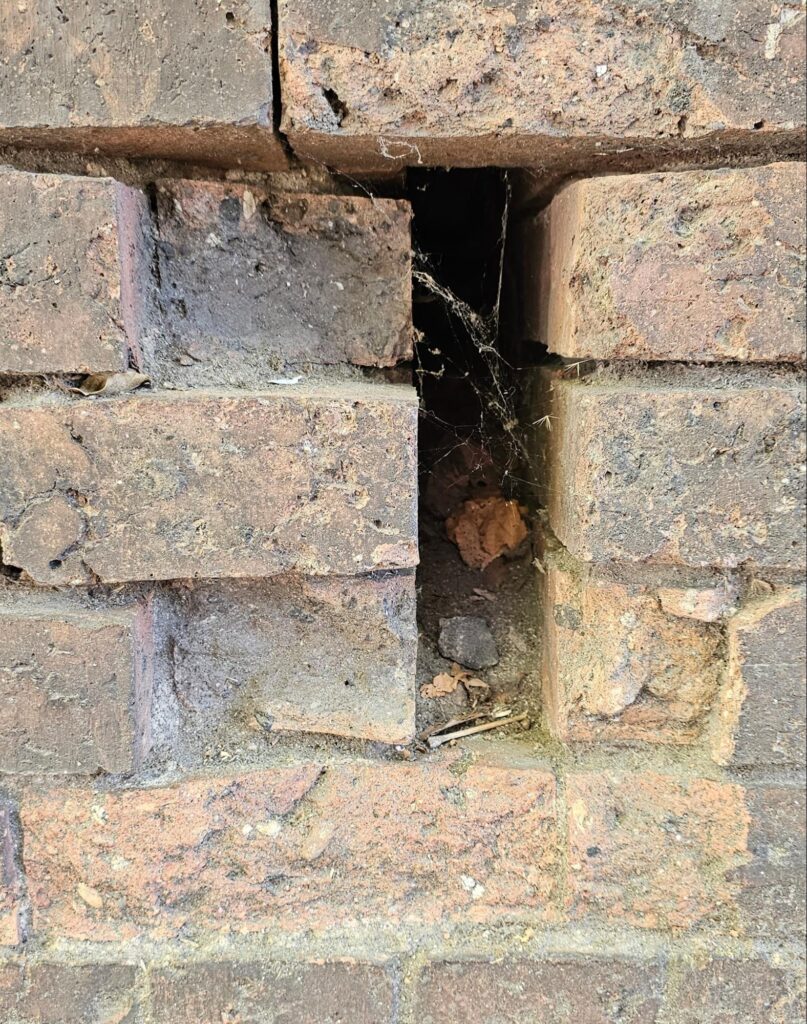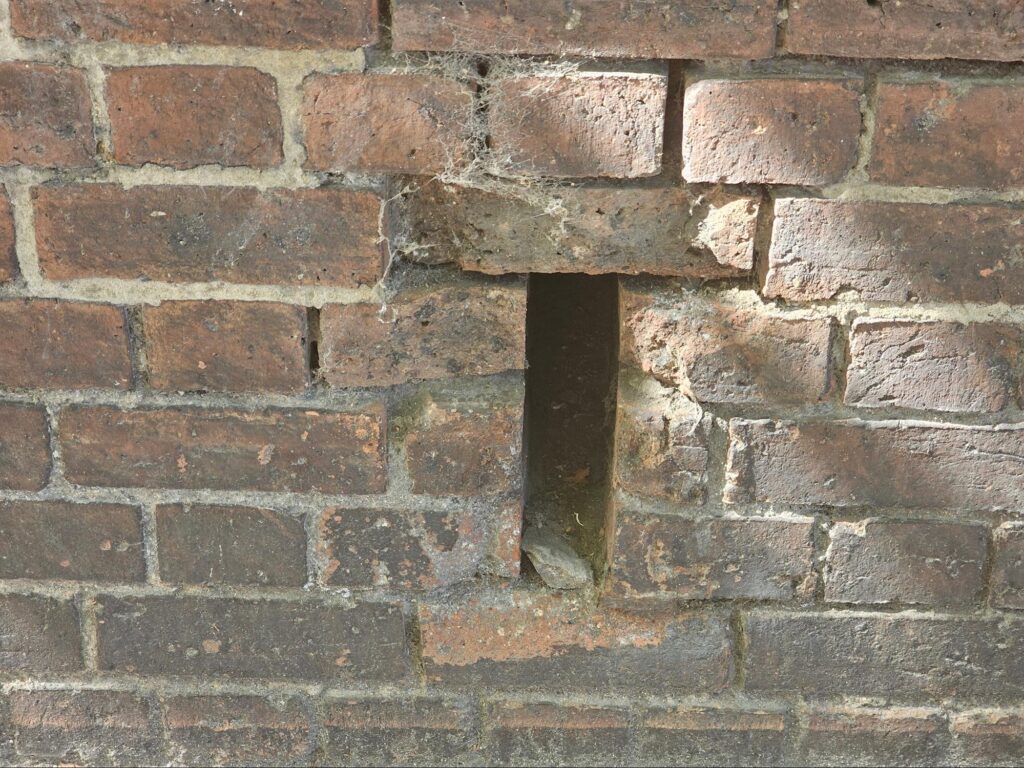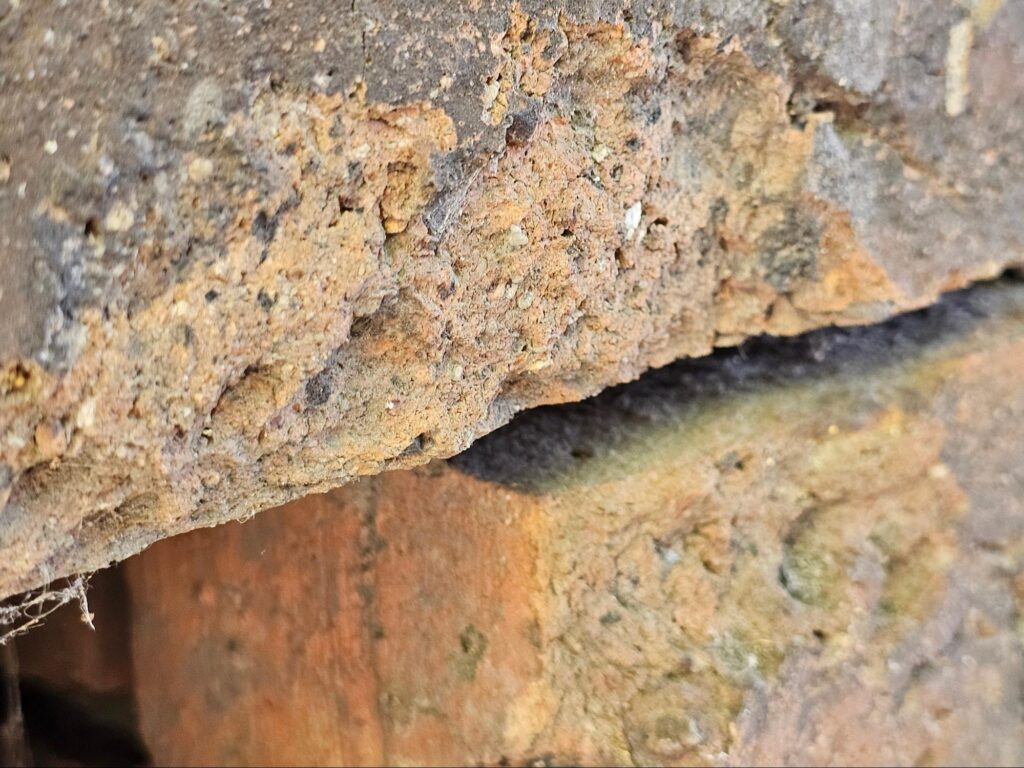Today we’re looking at another historic brick retaining wall, built over 100 years ago. At the time when this wall was built, the concepts and issues of deterioration and destabilization of historic brick masonry related to hydrostatic pressure were understood yet some of the technology we use today was not available to build elaborate hydrostatic pressure relief systems. In fact, here in Washington DC, even our retaining walls built 100 years ago, particularly many of the salt and pepper granite stone retaining walls with toothpaste mortar joints at the front yards of our city houses, are built without any weeps or hydrostatic pressure relief systems. These types of retaining walls are very common in many historic neighborhoods of DC such as Capitol Hill.
The wall below is built with a low temperature fired brick and has a 1.5 or 2 in x 8” slot cut vertically into the face of the wall. This slot works as a weep, but instead of being installed with a terracotta drain tile or a PVC pipe through the wall, the opening just allows water to relieve without a sleeve or perforated collection pipe.

The brickwork around the opening has significant mortar deterioration and really needs to be repointed and have the historic mortar joints restored overall. You can see that there is spailing around the edges of the opening, in fact all eight bricks that border the opening have spalling at the face of the brick.

Particularly, when you look at the picture below you can see that the bricks just above the head of the opening have deep dark shadows at the mortar joints indicating recesses and voids that are open and should be repointed with a mortar that is specially created to match the historic characteristics of the wall. These weeps were added later than they should have been, but it was still actually intelligent to add them because at this point they have mitigated lateral deflection. Lateral deflection is a bow or belly in a wall which eventually, if left unmitigated, leads to collapse of the wall and or building.
Brick spalling refers to the deterioration and detachment of the outer layers or surface of the brick, resulting in a pitted, eroded, or delaminated appearance. In some cases, here in Washington DC, particularly when contractors use the wrong type of mortar, the entire front face of a brick can cleave off. This is an example of a type of spalling. Spalling not only affects the aesthetic facade of the brickwork but also compromises the structural integrity of the masonry if left unaddressed.
When water penetrates the brick’s surface, it can become trapped within the porous material. During freezing temperatures, this moisture expands as it turns to ice, exerting a significant internal pressure that can cause the outer layers of the brick to break off or spall. The pressure is actually quite intense when measured on a PSI basis.) The presence of salts within the brick or mortar can also signal the signs or conditions which lead to deterioration and spalling when the brickwork is exposed to concentrations of moisture, such as improperly diverted rainwater. These salts can dissolve in the absorbed moisture and then recrystallize as the water evaporates, creating internal stresses that lead to the detachment of the brick surface. Salt and mineral deposits like this on the face of masonry will often be referred to as efflorescence.
Thermal expansion and contraction is an even greater cause of brick spalling (but its a bigger issue because it exacerbates conditions where improper tuckpointing or repointing was done in the past), in our DC climate zone, because of our area’s extreme temperature fluctuations from both winter to summer and even within one day. The different rates of thermal expansion between the brick and the surrounding mortar can create stresses that ultimately result in the spalling of the brick surface. As well, chemical reactions, such as exposure to acids or alkalis, can also cause deterioration and spalling by reacting with the components of the brick material. For this reason, particularly, make sure you’re not letting inexperienced contractors do work on your house or building. In addition to these environmental factors, mechanical damage from physical impacts, abrasion, or weathering effects like wind-driven rain or sandblasting can gradually erode the brick surface over time, leading to spalling.

Mitigating the underlying causes of spalling will involve addressing moisture issues by improving drainage systems, and in this case and many require repointing deteriorated mortar joints with compatible materials to reduce moisture penetration. In some instances, spalling may indicate underlying structural issues that require reinforcement or stabilization measures to prevent further deterioration.

Our company, Dupont Tuckpointing and Masonry, specializes in masonry restoration, historic brick repointing, and tuckpointing services in the Washington D.C. area. These buildings are uniquely historic, and their preservation requires skilled masons who are technically trained in the best practices and knowledge of proper restoration techniques.
We understand the significance of maintaining the architectural integrity of these historic structures, and our team of experienced professionals is dedicated to delivering exceptional craftsmanship. Whether you require masonry restoration, tuckpointing, or brick repointing services, we are here to help.
At Dupont Tuckpointing and Masonry, we take pride in our work and strive to ensure that every project is executed with the utmost care and attention to detail. We are committed to preserving the rich heritage of Washington D.C.’s built environment for generations to come.
If you have any questions or needs regarding masonry restoration, historic brick repointing, or tuckpointing services, please do not hesitate to reach out to us. We would be delighted to assist you and provide you with the expertise and quality workmanship that your historic property deserves.
You can reach us by telephone at (202) 796-7644 and you can reach us by email from the contact form on our website at https://duponttuckpointingmasonrydc.com/contact-us/.




